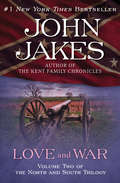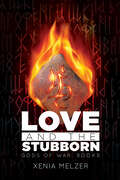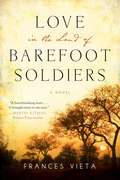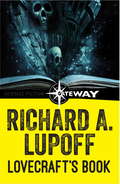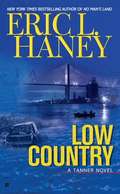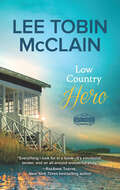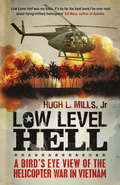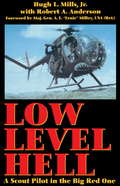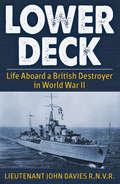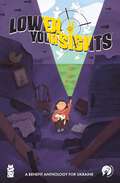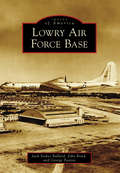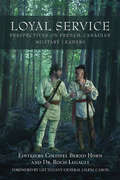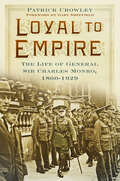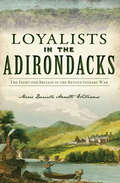- Table View
- List View
Love and War: North And South, Love And War, And Heaven And Hell (The North and South Trilogy #2)
by John JakesThe Main and Hazard families clash on and off the Civil War&’s battlefields as they grapple with the violent realities of a divided nationAmerica&’s master storyteller continues his reign with Love and War, a story steeped in passion and betrayal. With the Confederate and Union armies furiously fighting, the once-steadfast bond between the Main and Hazard families continues to be tested. From opposite sides of the conflict, they face heartache and triumph on the frontlines as they fight for the future of the nation and their loved ones. With his impeccable research and unfailing devotion to the historical record, John Jakes offers his most enthralling and enduring tale yet. This ebook features an illustrated biography of John Jakes including rare images from the author&’s personal collection.
Love and the Stubborn (Gods of War #2)
by Xenia MelzerGods of War: Book IIAll is fair in love and war. By now, Renaldo has found out the hard way how utterly stupid this statement is once you've met your match. And Casto won't give an inch in their ongoing war for love. After a tumultuous start to their relationship, Renaldo and Casto seem to have finally reached calmer waters. But just when Renaldo starts getting comfortable and thinks he can relax, things get out of hand again. His old enemy, the Good Mother, is dangerously close to defeating the divine brothers by reaching out to what is most dear to him. Casto still clinging to his stubborn pride is all the plotters need to drive him and Renaldo apart. Burdened by the secrets of his past, Casto fights with everything he's got not only to save his life, but also to secure his future happiness. Facing the destruction of everything they have built together, Renaldo and Casto must choose between pride and love.
Love for a Soldier: A captivating romantic adventure set in WW1 that you won’t want to put down
by Mary Jane StaplesA must read for fans of Katie Flynn, Fiona Valpy and Kristin Hannah - this is an enthralling and gripping romantic adventure from the multi-million copy seller Mary Jane Staples.READERS ARE LOVING LOVE FOR A SOLDIER! "As with all books by this author it is a top quality read..." - 5 STARS "What a great book - had a job to put it down. Recommend this book: 5 stars and more..." - 5 STARS "Excellent, thrilling and exciting." - 5 STARS****************************SHOULD SHE STAY LOYAL TO HER COUNTRY, OR THE MAN SHE LOVES?France, 1918: When Sophia, the rebellious daughter of a distinguished German general, witnesses a dramatic battle in the skies that leaves an English pilot without a plane and under the misapprehension that Sophia is on his side, she finds she has no choice but to agree to assist him in his attempt to avoid capture. He joins her in the family car she has stolen, trailed by both the German Army and a staff officer under strict instructions from Sophia's father to bring her home. With their pursuers hot on their heels, how will Sophia explain her behaviour, protecting a man she is supposed to hate? And after sharing so many adventures, will she be able to turn the flying officer in when the time comes?
Love in the Alaskan Wilds (A Wild Coast Novel)
by Jennifer SnowWill they play it safe…when falling in love means breaking all the rules?Treasure hunter Anna Armos has come to Port Serenity with a map and a mission: find the Winters Lot fortune. But along with the legendary gold, she&’s seeking the truth—the long-lost answers that will bring her family back together. Finding them requires bending a few protocols, but luckily, Anna knows just who to call…On a forced leave of absence from the coast guard, daredevil pilot Dwayne Madden feels like his future is up in the air. So when he gets a special request to escort the gorgeous Anna on a helicopter tour that&’s a little off course, it&’s hard to say no. Together, Anna and Dwayne journey deep into the untamed Alaskan wilds, but will they find the missing gold or follow an uncharted path to an even greater treasure?
Love in the Land of Barefoot Soldiers: A Novel
by Frances VietaCan newfound love survive the ravages of modern warfare in the land of the Queen of Sheba?Twenty-something Ceseli Larson is mourning the recent death of her cherished father. His passing comes as she prepares to undertake a planned but harrowing expedition to the lost ruins of Axum. Axum, capital of an ancient kingdom and the possible resting place of the Ark of the Covenant, was also once the famous home of the Queen of Sheba. Ceseli hopes to uncover its long-forgotten archaeological mysteries.What she does not count on, though, is that Benito Mussolini's invasion of Ethiopia looms on the horizon, about to be unleashed, sending an already dangerous journey into chaos. Nor does she expect the feeling she discovers for a young Italian doctor, nor the romance that blossoms between them.Love in the Land of Barefoot Soldiers is a sweeping tale of romance and war, as Ceseli is caught between the movements of empires and her growing love for a member of the invading army. History and the destruction of the modern era collide in this exciting drama.
Love is Blind: A gripping saga of war, tragedy and bitter jealousy
by Anne BakerA family struggles to survive bereavement, bombing and bitter rivalry... Love is Blind is a gripping wartime saga from much-loved author Anne Baker, which follows a family's path through heartache and war. Perfect for fans of Katie Flynn and Sheila Newberry.Patsy Rushton's brother Barney doesn't know the meaning of hard work, so when their father tragically dies, Patsy has no choice but to save the family's business. Meanwhile, Barney has got his girlfriend pregnant and, feeling trapped, he abandons her and leaves Merseyside altogether. But trouble follows Barney wherever he goes and when he learns of his sister's growing success, he can't help feeling resentful. Why is their mother, Beatrice, so quick to forgive him? Surely, she can't be blind to his faults? As Patsy is to discover, there's something else about Barney that is frightening her mother so much she has never dared to speak of it before. What readers are saying about Love is Blind: 'Very good, easy read. The twists and turns in the plot kept the intrigue alive. I would recommend to anyone''Engaging characters and a gripping war time story. A good insight into life during the war. Can't wait to read another of Anne Baker's books'
Love on the Battlefield: Rebellious Brides for Regency Soldiers (Brides of Waterloo)
by Louise Allen Sarah Mallory Annie BurrowsHarlequin Historical brings you three Regency romances in one collection. Love is forged on the battlefield, as three Waterloo soldiers find three brides!A Lady for Lord Randall by Sarah MalloryIndependent schoolmistress Mary Endacott has no intention of ever surrendering to a man – especially when she meets stubborn yet infuriatingly handsome Lord Randall! But with a major battle fast approaching normal rules dissolve, and Mary gives into desire.Justin is renowned for his authority on the battlefield, but Mary is a challenge of a whole new kind! He&’s determined to seize every moment of happiness while he can, but when the fighting commences will the promise of Mary&’s kiss be enough to keep him safe?A Mistress for Major Bartlett by Annie BurrowsMajor Tom Bartlett is shocked to discover that the angel who nursed his battle wounds is darling of the ton Lady Sarah Latymor. One taste of her threatens both her impeccable reputation and his career!An honourable man would ask for her hand, but Bartlett is considered an unrepentant rake by polite society – sweet Sarah would be spurned as his mistress and even as his wife. He demands she leave, but Sarah is just as determined to stay…by his side and in his bed!A Rose for Major Flint by Louise AllenMajor Adam Flint&’s is illegitimate, a roughened soldier, and an incorrigible rake – but Rose has never met a man so defined by honour.Who else, when faced with a lady rendered memory-less by the traumas of war, would resist the intense attraction that burns between them? Rose might not know her own name, but she knows her heart – and her heart wants Flint!Previously published as:Brides of Waterloo Miniseries miniseriesLove forged on the battlefield… A Lady for Lord Randall by Sarah Mallory A Mistress for Major Bartlett by Annie Burrows A Rose for Major Flint by Louise Allen
Love, Oil And The Fortunes Of War
by Paul HarrisA rollicking fictionalised tale about (real life) powerful characters, and how by helping preserve the dominance of the British Navy they arguably altered the outcome of WW1.Main characters: Gertrude Bell (famous explorer, archaeologist and supporter of women&’s rights – Nicole Kidman play her in the film Queen of the Desert); Admiral Jacky Fisher (a respected naval officer and the father of the Dreadnought, the first battleship and a key weapon in WWI); and William D'Arcy (Australian mining magnate who founded the oil industry in Persia). Story has many crosscurrents and themes and includes romance, tragic love entanglements, suicides, war – all against the backdrop of northern Queensland, Persia (modern Iran), WW1 and Gallipoli.
Love, Tommy: Letters Home, from the Great War to the Present Day
by Andrew RobertsA legacy of an empire and a nation at war, Love Tommy, is a collection of letters housed at the Imperial War Museum sent by British and Commonwealth troops from Canada, Australia, New Zealand and South Africa from the frontline of war to their loved ones at home. Poignant expressions of love, hope and fear sit alongside amusing anecdotes, grumbles about rations and thoughtful reflections, eloquently revealing how despite the passage of time many experiences of the fighting man are shared in countless wars and battles. From the muddy trenches of the Somme to frozen ground of the Falklands to the heat and dust of Helmand today, these letters are the ordinary soldier's testament to life on the frontline.
Lovecraft's Book: Lovecraft Book 1
by Richard A. LupoffWhen unworldly fantasist H.P. Lovecraft was approached by crafty fanatic George Sylvester Viereck to write an American Mein Kampf, the bait was almost irresistible.If Lovecraft would lend his pen and his Anglo-Saxon stock to the fascist cause, Viereck would arrange the publication in proper book form of a volume of his stories, hitherto scattered in pulp magazines.Whilst the famous horror writer had some pretty obnoxious political opinions, his friends didn't really believe he knew what deep waters he was getting himself into. And so began a concerted effort to keep H.P. Lovecraft out of the clutches of the forces of darkness that were to plunge the world into war...
Lovely War
by Julie BerryA sweeping, multi-layered romance set in the perilous days of World Wars I and II, where gods hold the fates--and the hearts--of four mortals in their hands. <P><P>They are Hazel, James, Aubrey, and Colette. A classical pianist from London, a British would-be architect-turned-soldier, a Harlem-born ragtime genius in the U.S. Army, and a Belgian orphan with a gorgeous voice and a devastating past. Their story, as told by goddess Aphrodite, who must spin the tale or face judgment on Mount Olympus, is filled with hope and heartbreak, prejudice and passion, and reveals that, though War is a formidable force, it's no match for the transcendent power of Love. <P><P>Author Julie Berry's critically-acclaimed writing has been called "haunting and unforgettable" by New York Times bestselling author of Salt to the Sea Ruta Sepetys and "utterly original and instantly engrossing" by Publishers Weekly.
Loving You Is Easy
by Wendy S. MarcusShe's a survivor of the front lines of politics. He's a wounded soldier returning home from the battlefield. Can they place their trust in the power of love? Nobody plays the role of perfect politician's daughter better than quiet, respectable math teacher Brooke Ellstein. But she won't be caught swimming with the sharks again, not after the son of a wealthy donor sinks his teeth into her and gets away with it. Still, political connections have their perks, such as heading up the governor's "Support Our Troops" pen-pal initiative--and getting first dibs on the smoking-hot sergeant whose picture shakes her right down to her goody-two-shoes. When corresponding with sweet, classy Brooke, Shane Develen instinctively hides his commando tattoos and blue-collar roots--and he can tell that she's hiding something, too. But Shane knows he's gained her trust when Brooke gives him a blisteringly sexy photo. Then he's injured in an ambush and a fellow soldier posts the snapshot online. Overnight, Brooke's reputation turns to ashes. Even though he's totally wrong for her, Shane shows up on Brooke's doorstep, determined to set things right--and discovers that right or wrong has nothing on the chemistry they share. Praise for Loving You Is Easy "A fresh story, memorable characters, and breathtaking romance . . . You must read this book!"--New York Times bestselling author Jennifer Probst"Wendy S. Marcus writes believable characters and tons of emotion."--USA Today bestselling author Sarah Morgan "Loving You Is Easy is a pleasing blend of sexiness and emotionally charged conflict that kept me turning the pages. Wendy S. Marcus doesn't shy away from tough subject matter; she embraces it in a real, visceral way that tugs on the reader's emotions and has you rooting for the characters not just to succeed but to heal, physically and emotionally. The story is unique, the characters flawed but wonderful. Fantastic!"--New York Times bestselling author Donna Alward"A unique story with emotional twists and turns on the road to happily ever after."--New York Times bestselling author Carly Phillips"Loving You Is Easy is a super sexy yet incredibly tender love story that'll leave you wishing for just a few more pages . . . and then a few more after that."--Laura Drewry, USA Today bestselling author of Prima Donna "Loving You Is Easy drew me in on the first page and held me until the last. A great read."--Claudia Connor, author of Worth the Fall"This is a fabulous read I know I will reread in the future. Wendy S. Marcus is a total treat!"--Rakes of Romance "I highly recommend this read for all fans of romance. . . . [Loving You Is Easy has] drama, passion, intrigue and one of the most beautifully written endings I have read in a long time."--Contemporary Romance Reviews "Incredible . . . Loving You Is Easy is a truly unique story with complex characters, unexpected emotional twists, and a burst of realism that convincingly illustrates just how completely opposites can attract and grow together."--Fic Central "With a bit of grouch and a whole lot of classy, Wendy's newest release gives a good read!"--Maldivian Book Reviewer's Realm of Romance Includes a special message from the editor, as well as an excerpt from another Loveswept title.
Loving a Warrior: A Navy Seal Gay Romance (Loving a Warrior #1)
by Melanie HansenBUD/S: six months of the most intense training there is. It’s survival of the toughest, and Matt Knytych is determined to come out the other side a navy SEAL.Distraction is life or death. And just the sight of former marine Shane Hovland is enough to shake Matt’s concentration.Shane came to BUD/S training ready to prove himself—again. Semper Fi is forever, but he needs a new start. Not this dangerous heat with a man he barely knows.Everything they’ve ever wanted is riding on a thin, punishing line. And they’ll have to fight for more than just each other if they want to make it through intact.After all, the only easy day was yesterday. This book is approximately 77,300 wordsOne-click with confidence. This title is part of the Carina Press Romance Promise: all the romance you’re looking for with an HEA/HFN. It’s a promise!
Low Carb High Fat and Paleo Slow Cooking: 60 Healthy and Delicious LCHF Recipes
by Birgitta HoglundSlow food, in the form of slow cooking and old-fashioned home cooking, has become really hot. Rich stews, roasts, soups, and stocks are now simmering in many kitchens. A stew cooked slowly over low heat for several hours works wonders even with the simplest and least expensive cuts of meat. The food takes care of itself while you’re doing other things, and a few hours later it has evolved into an amazing taste experience. Slow food is perfect for the low carb high fat (LCHF) and paleo diets, which emphasize proteins and vegetables over sugar and flour. Low Carb High Fat and Paleo Slow Cooking offers sixty amazing recipes for recognizable favorites with new twists from a variety of cuisines. Dish up that Sunday roast with blueberry cream sauce, salted pork with cauliflower puree, and saffron-scented seafood stew interspersed with recipes inspired by author Birgitta Höglund’s many trips to various Mediterranean kitchens. From these regions, she presents nutritious dishes with gentle but intense flavors like lemon stuffed chicken, Turkish lamb stew, Greek stifado, meat sauce with sundried tomatoes, and pulled pork with flavor from the Cypriot cuisine. Many people simply prefer to eat simple, natural food without preservatives, and Low Carb High Fat and Paleo Slow Cooking is here to provide delicious, slow-cooked meals that are healthy for the whole family.
Low Country
by Eric L. HaneyKennesaw Tanner used to be a shadow operative. Now, he operates on his own. Tanner is in the coastal swamps of Georgia, hunting for the man who may have killed his friend. But he soon finds himself caught up in a running battle against a ring of brutal sex slavers for whom human life is a cheap commodity. Tanner must overcome soul-blackening corruption and confront the most inhuman degradation if he's going to make them pay.
Low Country Hero: A Clean & Wholesome Romance (The Safe Haven Novels #1)
by Lee Tobin McClainA single mother starts fresh in smalltown South Carolina, helping a rugged contractor renovate homes in this clean & wholesome romance series launch.Sunny, carefree days splashing in the ocean—it’s the life Anna George has always wanted for her five-year-old twins. And now that they’ve made it to Safe Haven, South Carolina, she won’t let anyone stand in her way. Not the abusive ex she’s just escaped and not the rugged contractor who caught her setting up house in the shuttered beachfront cabins he’s refurbishing. When he offers Anna and her daughters a place to stay in exchange for her help with renovations, she’s tempted. His gentle way with her girls makes her want to trust him, but she’s been wrong before . . . A family is the last thing contractor and former military man Sean O’Dwyer wants right now. But when he discovers Anna and her girls, he recognizes kindred spirits. They’re survivors who’ve seen the worst of people, just like he has, and he’ll do anything he can to help them. As he and Anna spend their days bringing the cottages back to life and their nights sharing kisses in the warm bayou breezes, Sean must choose between the life he always wanted and the family he can’t live without.Praise for Low Country Hero“Low Country Hero has everything I look for in a book—it’s emotional, tender, and an all-around wonderful story.” —New York Times–bestselling author RaeAnne Thayne“[An] enthralling tale of learning to trust. . . . This enjoyable contemporary romance will appeal to readers looking for twinges of suspense before happily ever after.” —Publishers Weekly“Fans of Debbie Macomber will appreciate this start to a new series by McClain that blends sweet, small-town romance with such serious issues as domestic abuse. . . . Readers craving a feel-good romance with a bit of suspense will be satisfied.” —Booklist
Low Level Hell: A Scout Pilot In The Big Red One
by Robert Anderson Hugh Mills'The best 'bird's eye view' of the helicopter war in Vietnam in print today ... Mills has captured the realities of a select group of aviators who shot craps with death on every mission' R.S. Maxham, Director, US Army Aviation MuseumThe aeroscouts of the 1st Infantry Division have three words emblazoned on their unit patch: Low Level Hell. It was the perfect concise defininition of what those intrepid aviators experienced as they ranged the skies of Vietnam from the Cambodian border to the Iron Triangle. The Outcasts, as they were known, flew low and slow. They were the aerial eyes of the division in search of the enemy. Too often for longevity's sake they found the Viet Cong and the fight was on. These young pilots, who were usually 19 to 22 years old, invented the book as they went along.
Low Level Hell: A Scout Pilot in the Big Red One
by Hugh MillsThe aeroscouts of the 1st Infrantry Division had three words emblazoned on their unit patch: Low Level Hell. This was the perfect definition of what these pilots experienced as the ranged the skies of Vietnam. Mills tells the combat experiences of these aviators.
Lower Deck: Life Aboard a British Destroyer in WWII
by Lieutenant John DaviesLower Deck, first published in 1945, is a journal-like, exciting recounting of life aboard a Royal Navy destroyer, the H.M.S. Sikh (due to wartime regulations, the ship’s name in the book is the H.M.S. Skye); the ship is stationed in the eastern Mediterranean in the defense of Malta. Centering on the lives of the crewmen who are part of a gun crew, the book portrays the ship’s almost daily encounters with German and Italian ships and planes (as the author states: “...Daylight each morning brings with it almost complete certainty of attack...the comparatively confined waters, the proximity and strategic excellence of Axis air bases, means that to avoid discovery and attack is virtually impossible.”) Eventually, the Skye’s luck runs out and on September 14, 1942, she is sunk by German artillery with the loss of 115 men, with more men taken prisoner, and others rescued by nearby friendly ships. Includes a Glossary of naval terms used in the book.
Lower Your Sights: A Benefit Anthology For Ukraine
by VariousA new era for the iconic detective starts here, from bestselling and acclaimed authors Alex Segura and Michael Moreci, as an all-new, noir-infused chapter in the Dick Tracy legacy kicks off with superstar artist Geraldo Borges.
Lowry Air Force Base (Images of America)
by John Bond Jack Stokes Ballard George PaxtonFrom 1937 to 1994, Lowry Air Force Base, located on the eastern edge of the city of Denver, served the nation and the surrounding community in many distinguished ways. The air base, primarily a technical training center, graduated more than 1.1 million enlisted members and officers in skills ranging from armament to photography, tremendously strengthening the country's war efforts in World War II, the Korean War, the Vietnam War, and the Cold War. In addition, from the 1980s, Lowry Air Force Base remained one of Colorado's largest employers, with approximately 10,000 military and civilian men and women, providing an economic impact approaching $1 billion annually. Thus Lowry significantly contributed to maintaining the world's largest air force and to promoting the accelerated growth of the Denver metro area and Colorado.
Loyal Service: Perspectives on French-Canadian Military Leaders
by Colonel Bernd Horn Roch Legault Lieutenant-General J.H.P.M CaronFrench Canadians have a long, proud history of serving their nation. From the earliest beginnings, French Canadians assisted in carving out and defending the nascent country. They were critical as defenders and as allies against hostile Natives and competing European powers. In the aftermath of the conquest, they continued, albeit under a different flag, to defend Canada. Loyal Service examines the service of a number of French-Canadian leaders and their contributions to the nation during times of peace, crisis, and conflict spanning the entire historical spectrum from New France to the end of the twentieth century.
Loyal to Empire: The Life of General Sir Charles Monro, 1860-1929
by Gary Sheffield Patrick CrowleyWinston Churchill did not describe General Sir Charles Monro in the most glowing terms. Referring to Monro’s brave decision to recommend a withdrawal from the Gallipoli disaster, Churchill said: ‘He came, he saw, he capitulated.’ Monro was one of a handful of senior officers selected to command a division with the British Expeditionary Force in 1914 and also led a corps on the Western Front as the war progressed. After Gallipoli he was instrumental in supporting the war effort from India as commander-in-chief and was directly involved in the aftermath of the Amritsar massacre by Brigadier General Dyer. His earlier life included distinguished service on the North West Frontier and in South Africa, and he was responsible for dramatically improving tactics within the army. Loyal to Empire brings to life the interesting character of General Monro, perhaps the least well known of all the British First World War commanders, and reassesses the legacy of his important military contributions.
Loyal: 38 Inspiring Tales of Bravery, Heroism, and the Devotion of Dogs
by Rebecca Ascher-WalshThis treasury features heartwarming photographs and touching stories of dedicated working dogs who have gone above and beyond the call of duty and proven themselves as true heroes.This special collection of dog stories and photographs features four-legged heroes who have worked side by side with soldiers, searched the wreckage of natural and man-made disasters, changed families' lives through emotional support, and administered aid around the world and at home in the United States. Heart-warming photographs and touching anecdotes bring to life thirty-eight caring canines who have served the people who mean the most to them, from a German Shepherd who leads a blind man on his marathon training mssion to a belly rub-loving Sheltie who supports at-risk youth in the classroom. For anyone who has experienced the extraordinary affection of a dog, Loyal is a lasting celebration of the joys of canine companionship.
Loyalists in the Adirondacks: The Fight for Britain in the Revolutionary War
by Marie Danielle WilliamsFrom the outbreak of the Revolutionary War to the summer of 1777, Loyalists and Patriot forces wove their way through the mountains and valleys of the Adirondacks, vying for land and control of the key waterways of the Hudson River, Lake Champlain, the St. Lawrence River and the New York Harbor. The majority of New Yorkers, particularly those who occupied the Adirondack Mountain Region and other wilderness frontier regions, were either Loyalist or neutral throughout the war. Their stories, motivations and actions are often overlooked out of a false impression that most colonists were unifed in favor of American independence. Author Marie Williams recounts the harrowing efforts, battlefield endeavours and conflicted hearts and minds of the forgotten British and Loyalists during the revolutionary era in the Adirondacks.
